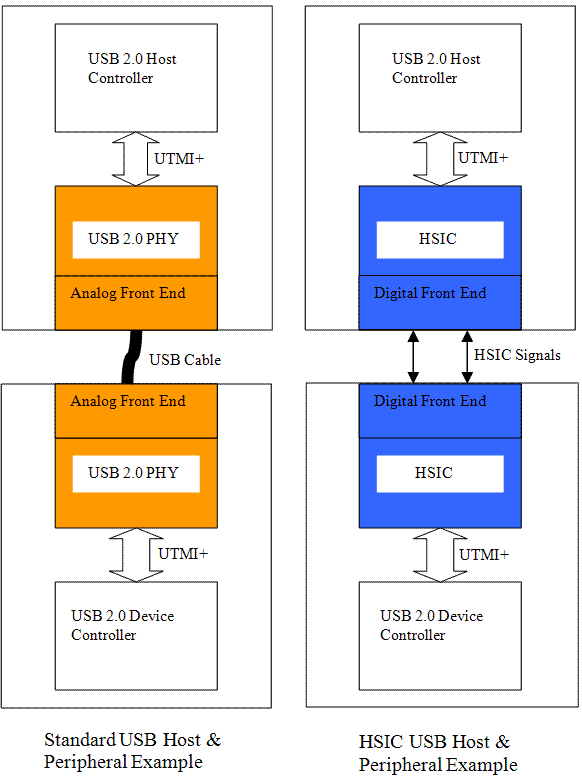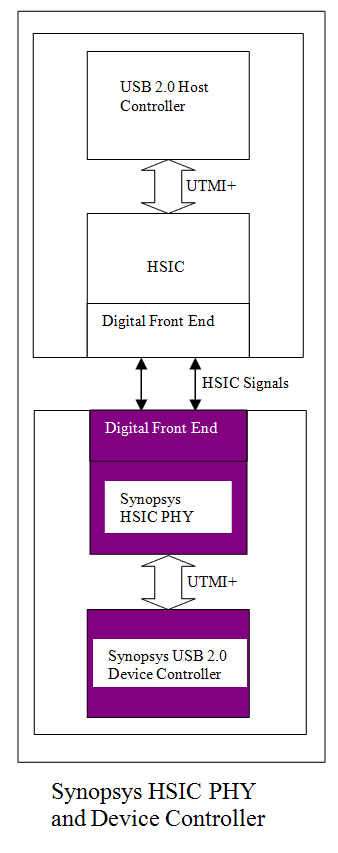USB High Speed Inter-Chip (HSIC) IP: What is it? And why should I use it?
来源: https://www.synopsys.com/dw/dwtb.php?a=hsic_usb2_device
What is HSIC?
HSIC (High-Speed Inter-Chip) is an industry standard for USB chip-to-chip interconnect with a 2-signal (strobe, data) source synchronous serial interface using 240 MHz DDR signaling to provide only high-speed (480 Mbps data rate). No external cables or connectors and hot plug-n-play are supported. There is also no analog transceivers, and hence reduces the complexity, cost, power consumption, and manufacturing risk. Low power can be achieved with 1.2 V LVCMOS signaling levels instead of the 3.3 V signaling requirement. Both data and strobe are bi-directional utilizing NRZI encoding. In addition, HSIC interface is always operated at high speed, 480 Mbps. Hence, no high-speed chirp protocol is needed during enumeration. Finally, HSIC USB is fully compatible with existing USB software stacks and provides all data transfer needs through a single unified USB software stack. For more technical information regarding the requirements to implement a HSIC USB solution, please refer to the High-Speed Inter-Chip USB Electrical Specification, Version 1.0 (a supplement to the USB 2.0 specification.) which is now available online at http://www.usb.org/developers/docs/docs

Why HSIC?
- HSIC replaces I2C
- I2C isn’t fast enough and requires special drivers
- HSIC allows USB Software reuse
- PHY reuse/adaptation of existing PHY technologies
HSIC Device Using Synopsys USB 2.0 Device Controller and HSIC PHY
USB chip-to-chip interconnect can be achieved with the use of both Synopsys device controller and HSIC PHY. It eliminates USB cables and connector connection down to two wires for high speed chip-to-chip communication. It also allows low power high-speed data transfers (480 Mbps) using a source-synchronous serial interface. By eliminating the need of 3.3 V signaling and 5 V short protection logic, Synopsys HSIC PHY can offer approximately up to 50 percent lower power and 75 percent smaller area compared to traditional USB 2.0 PHYs.

USB 2.0 HSIC PHY
- HSIC USB version 1.0 compliance
- HSIC USB Features
- Supports 8/16-bit unidirectional parallel interfaces for HS mode of operation in accordance with the UTMI+ specification
- Implements data recovery from serial data on the HSIC connector
- Implements SYNC/End-of-Packet (EOP) generation and checking
- Implements bit stuffing and unstuffing, and bit-stuffing error detection
- Implements Non Return to Zero Invert (NRZI) encoding and decoding
- Implements bit serialization and deserialization
- Implements holding registers for staging transmit and receive data
- Implements logic to support suspend, sleep, resume, and remote wakeup operations
- General Features
- Occupies small area
- Implements low power dissipation while active, idle, or on standby
- Implements one parallel data interface and clock for high-speed HSIC data transfers
- Provides parameter override bits for optimal yield and interoperability
- Provides on-chip PLL to reduce clock noise and eliminate the need for an external clock generator
- Provides Built-in Self-Test (BIST) circuitry to confirm high-speed operation
- Provides extensive test interface
- Technical Specification
- Small area with approx. 0.18 sq. mm (macro + pads)
- Low power
- HS transmit ~27 mW (typical)
- HS receive ~18 mW (typical)
- Suspend and sleep modes ~4uA
- Supports 12/24/48 MHz clock
- Initial process - TSMC 65LP
- Compatability
- The HSIC PHY uses the same UTMI interface to communicate with Synopsys device controller. Since there is no well defined standard on the UTMI interface for HSIC and we have not tested the HSIC PHY with non-Synopsys device controllers yet, we do not guarantee that the UTMI interface of HSIC PHY would work well with that of non-Synopsys device controllers.
- Availability
- Please contact Synopsys if you are interested in this feature for your USB product.
USB 2.0 Device Controller with HSIC feature
- Configuration
- New device controller configuration option is available to enable HSIC support.
- HSIC logic is implemented through an `ifdef statement. The logic will additionally be controlled by a strap pin.
- Device controller needs to be configured to support unidirectional UTMI PHY interface.
- New device controller configuration option is available to enable HSIC support.
- PHY interface specific
- No new pin is required to interface to Synopsys HSIC PHY for HSIC purposes. Unidirectional UTMI PHY interface is used.
- When the device controller is interfacing to Synopsys HSIC PHY, both the device controller and the PHY are of the understanding not to go through the chirp enumeration steps, but rather go to high-speed idle directly.
- Application Interface/logic
- New strap input pin from Application to enable/disable HSIC support (if the core is already configured to support HSIC through coreConsultant/RapidScript)
- This new strap input pin will not be existed if the device controller is configured not to support HSIC.
- Hardware impact
- Device controller will bypass the Chirp enumeration stage in the chirp_gen_state state machine of udc20_speed_enum module if HSIC feature is supported.
- The bypassing of the chirp enumeration stage will only happen if the associated strap signal is also enabled. If the strap signal is not yet enabled, the core will go through the normal chirp handshake mechanism to support non-HSIC PHY.
- Firmware impact
- No significant change is needed. Supporting high speed falling back to full speed mode is no longer needed when attaching to a HSIC USB host during enumeration because HSIC chip-to-chip interconnect supports high-speed operation only. Hence, a high-speed only device driver is needed.
- Compatability
- The device controller uses the same UTMI interface to communicate with Synopsys HSIC PHY. Since there is no well defined standard on the UTMI interface for HSIC and we have not tested the device controller with non-Synopsys HSIC PHYs yet, we do not guarantee that the UTMI interface of device controller would work well with that of non-Synopsys HSIC PHYs.
- Availability
- Please contact Synopsys if you are interested in this feature for your USB product.
USB High Speed Inter-Chip (HSIC) IP: What is it? And why should I use it?的更多相关文章
- Linux usb 1. 总线简介
文章目录 1. USB 发展历史 1.1 USB 1.0/2.0 1.2 USB 3.0 1.3 速度识别 1.4 OTG 1.5 phy 总线 1.6 传输编码方式 2. 总线拓扑 2.1 Devi ...
- Android 不通过USB数据线调试的方法
在开发Android应用时,通常情况下是通过USB数据线连接设备和计算机,但对于一些需要使用USB设备的应用,这种方法就碰到了麻烦,手机的USB接口已经和外接的USB设备连接,无法再连数据线,此时可以 ...
- USB眼图
/********************************************************************** * USB眼图 * 说明: * 对于USB眼图,并不是很 ...
- USB的挂起和唤醒(Suspend and Resume)【转】
转自:http://m.blog.csdn.net/blog/luckywang1103/25244091 USB协议的第9章讲到USB可见设备状态[Universal Serial Bus Spec ...
- PHP简单爬虫 爬取免费代理ip 一万条
目标站:http://www.xicidaili.com/ 代码: <?php require 'lib/phpQuery.php'; require 'lib/QueryList.php'; ...
- USB各种模式 解释
1.MTP: 通过MTP这种技术,可以把音乐传到手机里.有了U盘功能为什么还要多此一举呢?因为版权问题,MTP可以把权限文件从电脑上导过去:如果只使用手机的U盘功能,把歌的文件拷过去之后,没有权限文件 ...
- USB详解
USB作为一种串行接口,应用日益广泛.如同每个工程设计人员必须掌握I2C,RS232这些接口一样,我们也必须掌握USB.但是USB的接口协议实在有点费解,Linux UCHI驱动作者之一Alan St ...
- 技巧.【转】在虚拟机Vmware中使用HID设备(如USB免驱键盘)
ZC:我的环境:Win7x64.VMware10 ZC:我的处理: ZC: (1).usb.generic.allowHID = "TRUE" (本来就有,将它的位置提前) ZC: ...
- STM32 USB复合设备编写
目的 完成一个CDC + MSC的复合USB设备 可以方便在CDC,MSC,复合设备三者间切换 可移植性强 预备知识 cube中USB只有两个入口. main函数中的MX_USB_DEVICE_Ini ...
随机推荐
- 全局axios默认值 和 自定义实例默认值
首先说了一下情况, 登录后成功返回token 然后在带着token去继续下面的请求, 奇怪的是都是当前页面起作用,刷新和跳转之后就token 就消失了. 查了 axios文档发现 被自己坑了 我设置了 ...
- 【git】git提交忽略不必要的文件或文件夹
对于经常使用Git的朋友来说,.gitignore配置一定不会陌生.废话不说多了,接下来就来说说这个.gitignore的使用. 首先要强调一点,这个文件的完整文件名就是".gitignor ...
- linux下面which whereis find locate的使用
我们经常在linux要查找某个文件,但不知道放在哪里了,可以使用下面的一些命令来搜索.这些是从网上找到的资料,因为有时很长时间不会用到,当要用的时候经常弄混了,所以放到这里方便使用. which ...
- Linux中短横线(-)小记
在Linux中短横线(-)可以表示输出流,具体用法如下. 搭配cat cat - 如果指定cat的文件为-,表示从标准输入读取(和直接使用cat,好像没什么区别) 搭配| echo 123 | cat ...
- Codeforces 362E Petya and Pipes 费用流建图
题意: 给一个网络中某些边增加容量,增加的总和最大为K,使得最大流最大. 费用流:在某条边增加单位流量的费用. 那么就可以2个点之间建2条边,第一条给定边(u,v,x,0)这条边费用为0 同时另一条边 ...
- 关于一些Java基础数据类型的常用方法的应用场景的小思考
昨天遇到一个问题,按照我的一半解决方法是传一个参数,然后通过参数来控制逻辑处理:但是领导发现String的一个方法也可以完全完成该问题!而我完全没有get到这个点! so,我认识到了自己的知识盲区:基 ...
- go语言中的json
结构体类型转化为json格式 package main import ( "encoding/json" "fmt" ) //如果要转化成json格式,那么成员 ...
- PC机做ISCSI存储服务器故障
物理主机:IBM x3650 6块SAS盘,分为两组RAID.一组系统,一组数据. zabbix监控告警情况如下: 早上上班,发现服务器无法连接,网络无法通信.让IDC重启,还是无法恢复正常. 去了机 ...
- 区块链开发(五)git、truffle安装
truffle是以太坊最受欢迎的一个开发框架,本篇博客介绍truffle的下载安装过程. git安装 在安装truffle之前需要核实一下本机是否安装git程序.后面的程序安装需要依赖git. 输入以 ...
- hdu 1932(spfa)
XYZZY Time Limit: 1000MS Memory Limit: 30000K Total Submissions: 3694 Accepted: 1059 Description ...
